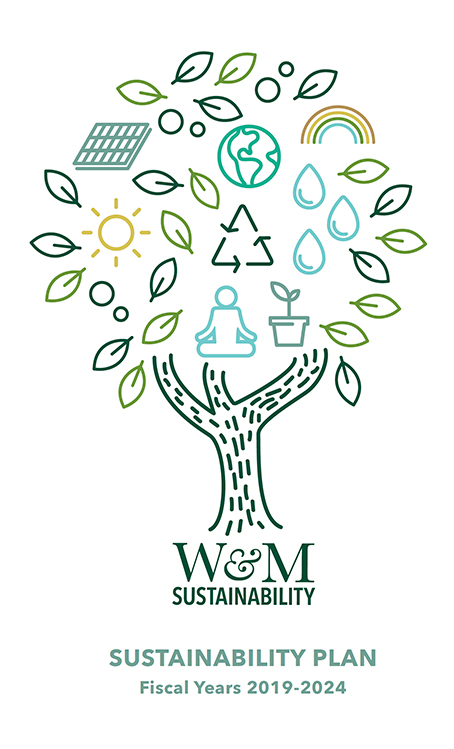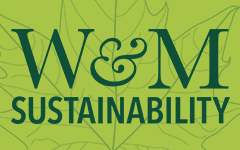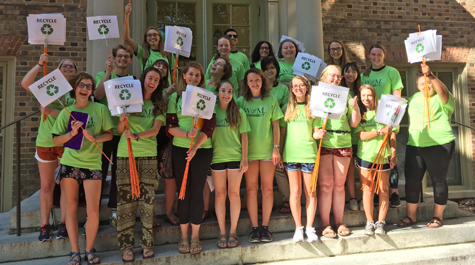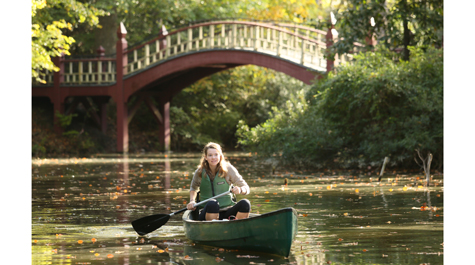William & Mary, UVA partner to reach 2030 carbon neutrality goal
W&M also announces $19.3 million gift to further conservation efforts
William & Mary and the University of Virginia have committed to becoming carbon neutral by 2030, the universities announced today. The two Virginia institutions will share information and collaborate on initiatives toward zero net greenhouse emissions. For W&M, those actions will include steps in efficiencies, sourcing renewable energy and behavior change.
William & Mary also announced today a $19.3 million anonymous donation to establish an Institute for Integrative Conservation, which will support policy research and advocacy to protect ecosystems and safeguard world populations against environmental threats. Expected to become operational in winter 2020, the institute will form multidisciplinary teams of faculty, staff and students to address conservation issues and establish a network of conservation professionals.
The announcements are part of broader sustainability efforts across the commonwealth. Virginia Gov. Ralph Northam signed an executive order earlier this fall setting a goal for Virginia to produce 100% of its energy from carbon-free sources by 2050.
“Safeguarding the health of our environment, society and economy is one of the most complex challenges of our time,” said W&M President Katherine A. Rowe, “and will require sustained effort, close collaborations and unwavering commitment from our institutions. William & Mary has committed itself to all of these in today’s announcements of our bold new efforts, as we promise to unite our best minds with others throughout the commonwealth. We look forward to working with our colleagues at the University of Virginia, and we recognize our responsibility to do our part, especially as an estuarine campus located in a region more susceptible to sea-level rise than many others.”
 The announcements also build on the ongoing progress in sustainability efforts at William & Mary. Last fall, the university announced a long-range Sustainability Plan, which includes a commitment to grow its green revolving fund, which invests in projects across campus that both reduce carbon emissions and generate a measurable return on investment, and to create a Climate Action Plan. Part of that plan will include steps toward the carbon neutrality goal.
The announcements also build on the ongoing progress in sustainability efforts at William & Mary. Last fall, the university announced a long-range Sustainability Plan, which includes a commitment to grow its green revolving fund, which invests in projects across campus that both reduce carbon emissions and generate a measurable return on investment, and to create a Climate Action Plan. Part of that plan will include steps toward the carbon neutrality goal.
“Climate change is a real threat and is something that we should be taking action on,” said Calandra Waters Lake, director of sustainability. “There is increasing evidence that we have a shrinking timeline in order to take that action, and although 2030 is ambitious, it is achievable. We believe it's the appropriate thing to do.
“Achieving this goal will involve everyone — faculty, students and staff. It's taken a lot of planning and stakeholder involvement from all areas of the campus to get to this point, and it’s the first step toward a much larger plan.”
Partnering with UVA
William & Mary and UVA will begin working toward achieving their shared goal in the spring. UVA’s Board of Visitors this week will review details of the partnership as well as the university’s overall 2020-30 Sustainability Plan. According to Waters Lake, the partnership will focus on three areas:
- Regularly sharing information and resources on climate action planning and implementation processes
- Collaborating on outreach and engagement opportunities within each university and between the universities and surrounding communities
- Working together to support other institutions of higher education and their communities in Virginia in climate action planning and implementation
The partnership is expected to help each school take swifter climate action, amplify effects and pool resources and knowledge, said Waters Lake.
“We tend to be competitive with other universities, especially with UVA,” said Biology Professor John Swaddle, co-chair of the Committee on Sustainability.
“Sustainability is one of those areas where it pays to be collaborative. Because the whole point of this topic is to do collective good, it's easier and more impactful if we do that in partnership with other institutions.”
Next steps
A large portion of the university’s greenhouse gas emissions comes from electricity, said Waters Lake. While past and current initiatives have reduced usage through efficiency measures such as LED bulbs, the next step is sourcing renewable energy, she said. As part of that effort, W&M Facilities Management is exploring a power purchase agreement that could source as much as 60% of the electricity used on campus from solar farms in the region.
“We believe we have an option to really address the largest source of our emissions, which is one of the reasons that we believe 2030 is so achievable,” said Waters Lake.
Another challenge William & Mary and many other universities face is the use of natural gas for heating and steam production, said Waters Lake, adding that it makes up about a quarter of W&M’s emissions. The university will hire a consultant to come to campus next semester to provide advice on technology and alternative sources.
 Carbon offsets may also play a role in the university’s efforts to address things like commuting and business travel. These credits are purchased by organizations to offset areas where achieving carbon neutrality may be very difficult or impossible to achieve. The money goes toward supporting tracked and verified projects that reduce greenhouse gases. The use of offsets will likely happen closer to the 2030 goal, once the university has explored all other options to reduce its carbon footprint, said Waters Lake.
Carbon offsets may also play a role in the university’s efforts to address things like commuting and business travel. These credits are purchased by organizations to offset areas where achieving carbon neutrality may be very difficult or impossible to achieve. The money goes toward supporting tracked and verified projects that reduce greenhouse gases. The use of offsets will likely happen closer to the 2030 goal, once the university has explored all other options to reduce its carbon footprint, said Waters Lake.
Several groups of people on campus, including those who are working on the Climate Action Plan, are thinking about the most viable carbon offset options, said Swaddle.
“We aren’t going to be a zero-emissions campus,” he said. “People are going to be doing things that result in carbon emissions, such as commute to work or study abroad. For those activities, which are essential, we will look for low-emissions options and offset what we cannot reduce. So, as a whole, collectively, we're at neutrality.”
Ongoing efforts
William & Mary has been working toward reducing its carbon footprint for years through W&M Sustainability, which includes the Committee on Sustainability, currently co-chaired by Swaddle and Chancellor Professor of Law Lynda Butler. The committee was created in 2008 after students called for the imposition of a student “Green Fee” to raise funds for sustainability efforts. Waters Lake was hired as the university’s first director of sustainability in 2014.
W&M’s sustainability efforts began in full force at the behest of students, said Butler, and they have been the driving force throughout the past decade.
“At the very beginning, we developed a policy of sustainability that focused mostly on environmental sustainability, but it's now been expanded,” said Butler, who has co-chaired the Committee on Sustainability since its inception.
Throughout the years, the committee, working with Waters Lake, has found ways to save the university significant amounts of money while pursuing green efforts, including an LED lighting retrofit that saves W&M $17,000 per year. That project was made possible through the university’s Green to Gold Fund, which gives loans to W&M departments for projects that reduce greenhouse gas emissions. The savings from those projects then fund other initiatives.
W&M Sustainability has also saved the university money by supporting the installation of variable drives in the HVAC system at Swem Library, identifying issues with the university’s recycling contracts and funding a move from a paper course catalog to an electronic one, said Butler.
Through the Green Fee, W&M Sustainability has awarded grants to students, faculty and staff each semester for projects that help make the campus more sustainable in some way, from water bottle-filling stations to a solar table and charging station on the Sadler Center terrace.
W&M Sustainability has also supported research opportunities for students and faculty, and some support is provided to faculty and students who attend conferences related to sustainability, said Butler.
Climate Action Plan
Last November, Rowe announced the adoption of the university’s first long-range, comprehensive Sustainability Plan, which included a commitment to the Sustainable Endowments Institute’s Billion Dollar Green Challenge. For colleges and universities, the goal of the challenge is to invest a combined total of $1 billion in self-managed green revolving funds. W&M will do this through private donations, Rowe said last year.
The plan also called for creating a Climate Action Plan, which is tentatively expected to launch in fall 2020. The university is currently working on that plan, building on the work that was done on the Sustainability Plan.
 The Office of Sustainability is facilitating the planning process with the climate action subcommittee of the Committee on Sustainability and about 10 working groups with faculty, staff and students from across campus.
The Office of Sustainability is facilitating the planning process with the climate action subcommittee of the Committee on Sustainability and about 10 working groups with faculty, staff and students from across campus.
The discussions occurring within those groups led to the university’s decision to move forward with setting a carbon neutrality date, said Waters Lake.
“It'll help inform the plan moving forward and make our efforts more targeted,” she said. “It's something that we've come to through a very long and inclusive process.”
The timing of the commitment also intersects with the university’s strategic planning process, which began in August.
“We want to make sure that as big decisions are made at the university, this 2030 carbon neutrality gets factored in,” said Waters Lake.
The initiative and date were accepted by the Committee on Sustainability and affirmed by the Faculty Assembly. It’s an ambitious goal, said Butler, but one that she thinks is achievable and is excited about, saying, “I think we've come a very long way.”
Get involved
People interested in getting involved can join the working groups for the Climate Action Plan, said Waters Lake. The plan itself will also provide opportunities for the campus community to play a role in reaching the goal through behavioral choices around things like transportation, recycling and energy usage.
Students will continue to play a significant role in sustainability efforts moving forward, said Swaddle.
“There’s an international call to action, which many scientists are calling a climate emergency or a climate crisis because we soon may reach a tipping point,” said Swaddle. “So there's a pressing need to do something in the coming decade, and William & Mary needs to play our part in that, and students need to see William & Mary is playing our part — it is a very important part of their education so they live as responsible citizens and leaders once they graduate.”
 Skip to main content
Skip to main content

